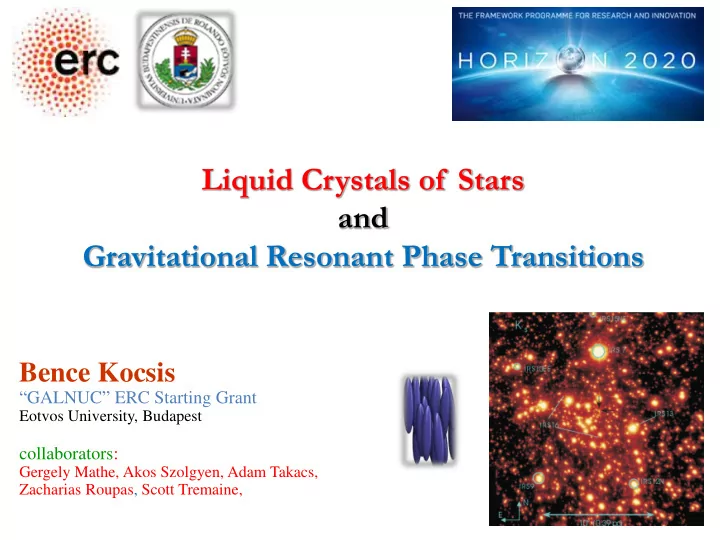

Liquid Crystals of Stars and Gravitational Resonant Phase Transitions Bence Kocsis “ GALNUC ” ERC Starting Grant Eotvos University, Budapest collaborators: Gergely Mathe, Akos Szolgyen, Adam Takacs, Zacharias Roupas, Scott Tremaine,
Types of relaxation • Collisionless relaxation (mean-field relaxation) • coarse-grained phase space density mixes • Violent relaxation • collisionless Boltzmann eq. + time-dependent potential • Collisional relaxation (thermal relaxation) • energy exchange, evolves toward equipartition • Resonant relaxation • action-angle variables • adiabatic invariants: inhibit relaxation • resonance between angles: accelerates relaxation
Relaxation hierarchy orbit in-plane precession reorientation semimajor axis change [1 — 10 4 yr ] [10 5 – 7 yr] [10 4 — 5 yr] [10 9 yr] static stationary stationary symmetries – spherical axi-symmetric spherical point-mass – semimajor axis semimajor axis semimajor axis adiabatic invariants eccentricity eccentricity eccentricity orbital plane orbital plane orientation of ellipse 2 phase space componens relax extremely quickly!! elliptic wire stationary annulus
Liquid crystals of stars to explain Anisotropy of massive stars Yelda+ 2014 Middle 0.13-0.27 pc Inside 0.03-0.13 pc Outside 0.27-0.47 pc Density map of angular momentum vector directions for massive stars at three different locations
Liquid crystals of stars to explain Anisotropy of massive stars Bartko+ 2009 Cos[ polar angle ] azimuthal angle azimuthal angle azimuthal angle Middle 0.13-0.27 pc Inside 0.03-0.13 pc Outside 0.27-0.47 pc Density map of angular momentum vector directions for massive stars at three different locations
Vector resonant relaxation Hamiltonian • average interaction effects over orbit and in-plane precession • only the angular momentum vector directions may change q ij • Hamiltonian (see Kocsis & Tremaine 2015 for details) Angle between orbit normals eccentricities masses semi-major axes
Similar models in condensed matter physics • Ferromagnetism • Liquid crystals • Spin glasses • Disordered systems: random variable coupling coefficients • Models with additional constraints • “frustrated” state
Results Mean field theory Monte Carlo Markov Chain RMS inclination [deg] Cos[ inclination ] distance from center [arcsec] Log[ distance from center / 4 arcsec ] Time evolution c.f: the observed distribution Cos[ inclination ] Log[ distance from center ]
Results
Monte Carlo Markov Chain • Assumption – distribution fills up phase space uniformly in the allowed region • Total energy fixed • Total angular momentum fixed • Method – Grab two angular momentum vectors Li, Lj – Rotate around sum Li+Lj by random angle – Check if total energy error is within a max tolerance
Monte Carlo Markov Chain
Monte Carlo Markov Chain
Final state in the simulation • Three snapshots in two simulations Heavy objects in a disk Heavy objects spherical Initially: Light objects spherical Light objects in a disk T=0 T=0 Cos[ inclination] T=500 T=500 T=1500 T=1000 Log(semimajor axis) Log(semimajor axis)
Statistical equilibrium • Objects fill up phase space uniformly in the allowed region tot E const Find maximum entropy configuration under constraints tot L const E ( L ) . L f ( L ) C exp kT Phase transition in inclination • Mean field theory • Maier & Saupe (1959) • keep only the quadrupole term • assume interaction dominated by stars on same radius • self-consistency equation for quadrupole moment
Mean field theory Maximum entropy with constraints • Particle number • Total resonant-relaxation energy • Total angular momentum
Free energy as a function of order parameters
Cos 2 [ inclination ] – 1/3 Mean field theory
Phase transition
Phase transition
Probability density
Negative temperature equilibria
Results with higher harmonics • Order parameters are the multipole moments. • First order phase transition in all order parameters • Ordered phase is dominated by quadrupole Takacs, Kocsis (2018)
Results with higher harmonics • Entropy – energy curve is qualitatively similar as in the simple case Takacs, Kocsis (2018)
Statistical physics from “molecular dynamics” • Statistical equilibria have lower Boltzmann entropy at intermediate energies • Stongly convex feature phase transition? Mathe, Kocsis in prep.
Ensemble inequivalence • Stability of equilibria are different in the canonical and microcanonical ensembles – No phase transition in microcanonical ensemble • Microcanonical ensemble of a one-component system cannot show a phase separation – This is due to the interaction energy between any two subsystems • There may be a phase separation in two component systems
Summary • Resonant effects accelerate relaxation in 2 phase space components • Liquid crystals have similar Hamiltonian • Disk at low temperature • Spherical phase at high temperature • Young stars in the Galactic center show a similar structure • First order phase transition Use this to – model the inclination distribution of different stellar types – predict the distribution of black holes
Hierarchy of Interaction Timescales vs. radius Semimajor axis change Eccentricity change Time scale Disk age Re-orientiation of orbital plane Precession in plane Keplerian orbit around SMBH Kocsis & Tremaine (2011)
Vector resonant relaxation Hamiltonian • mutual torques lead to relaxation of orbit normal vectors (angular momenta) q ij • self- gravitating system in “inclination” • interaction energy constant Legendre changes polinomial with time constant (depends on e, a )
Vector resonant relaxation Hamiltonian • mutual torques lead to relaxation of orbit normal vectors (angular momenta) q ij • self- gravitating system in “inclination” • interaction energy
Evidence for disrupted globular clusters? A fraction of stars was delivered by infalling globular clusters Fermi measured excess gamma ray emission from the Galactic bulge • Millisecond pulsars match the observed spectrum • Millisecond pulsars do not form in the bulge • Infalling globular clusters delivered the needed population (No need to invoke dark matter annihilation to explain the gamma ray excess, just ordinary MSPs) Brandt & Kocsis (2015)
Statistical equilibrium Maximum entropy with constraints • Particle number • Total resonant-relaxation energy • Total angular momentum
Phase diagrams Axisymmetric states Lopsided (triaxial) states total angular momentum total angular momentum
Statistical equilibrium
Order parameter
For a one-component system:
Free energy as a function of order parameters
Ensemble inequivalence
Recommend
More recommend